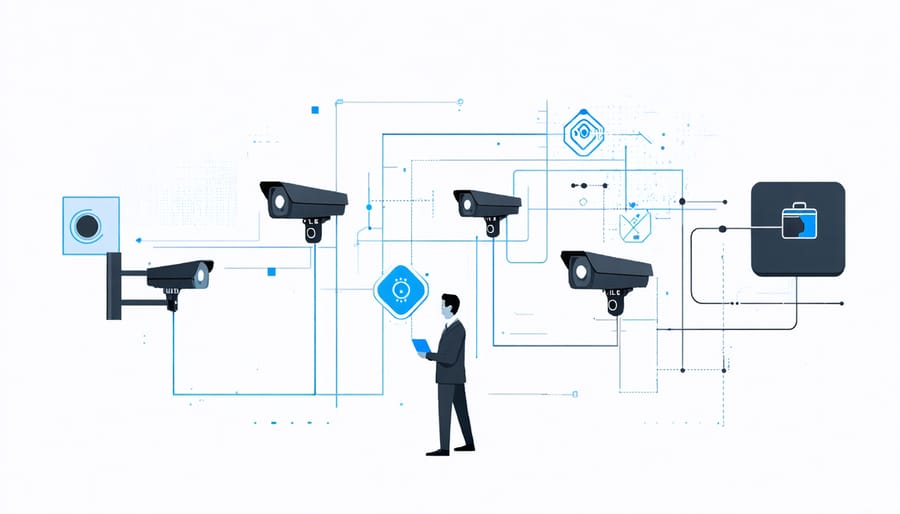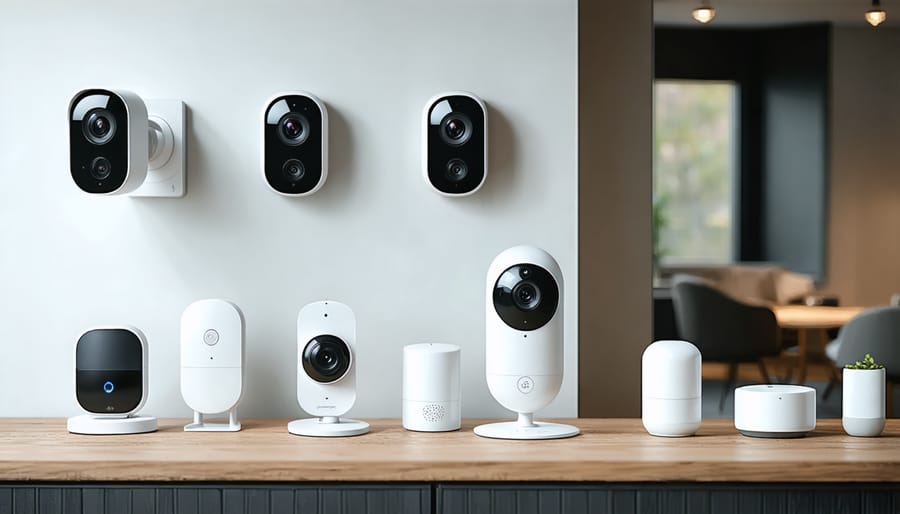Transform your home security with AI-driven threat detection systems that analyze patterns, movements, and sounds in real-time, delivering unprecedented protection for your family. Modern AI security protection goes beyond traditional motion sensors, using advanced algorithms to distinguish between routine activities and genuine threats.
Picture this: while standard security systems trigger countless false alarms from passing cars or swaying trees, AI-powered cameras learn your household’s normal patterns. They recognize familiar faces, detect unusual behavior, and alert you only when something truly requires attention. This intelligent filtering means fewer false alarms and more reliable protection when it matters most.
The technology has evolved to identify specific threats – from package thieves to unauthorized entry attempts – with remarkable accuracy. By combining visual, audio, and environmental data, these systems create a comprehensive security shield that adapts and improves over time, giving homeowners peace of mind without the hassle of constant false alerts.
This smart approach to home security represents a significant leap forward in protecting what matters most, making professional-grade surveillance accessible to everyday homeowners while maintaining privacy and control over their security data.
How AI-Driven Threat Detection Actually Works
The AI Security Brain
Think of your AI security system as a diligent student that’s constantly learning and getting smarter about protecting your home. These intelligent systems use advanced pattern recognition to understand what’s “normal” in and around your home, making them incredibly effective at spotting potential threats.
The AI brain works by analyzing countless data points from your security cameras and sensors. It learns your daily routines – when you typically come home, when the kids return from school, and even your pets’ movement patterns. This learning process helps it distinguish between ordinary activities and suspicious behavior.
For example, if someone usually approaches your front door around 2 PM for package delivery, the AI considers this normal. However, if someone lurks around your property at 3 AM, the system immediately flags this as unusual behavior. The AI can also recognize the difference between a swaying tree branch and a person trying to peek through your window.
What makes these systems particularly impressive is their ability to reduce false alarms dramatically. Unlike traditional motion sensors that might be triggered by passing cars or falling leaves, AI-powered systems use sophisticated algorithms to verify potential threats before alerting you, giving you peace of mind without unnecessary interruptions.

Smart Sensors and Cameras
Today’s smart security systems rely on a network of sophisticated sensors and cameras that act as the eyes and ears of your AI-driven protection. These devices work together seamlessly to gather real-time information about your home environment.
Motion sensors have come a long way from simple movement detection. Modern sensors can distinguish between pets and people, recognize specific patterns of movement, and even detect changes in heat signatures. Some advanced models can identify the sound of breaking glass or unusual vibrations that might indicate forced entry.
Security cameras now feature crystal-clear HD or 4K resolution, night vision capabilities, and wide-angle views that eliminate blind spots. Many include built-in features like two-way audio communication and automatic zoom functions that focus on activity when detected. Weather-resistant outdoor cameras can withstand harsh conditions while maintaining optimal performance.
What makes these devices truly “smart” is their ability to process information locally before sending relevant data to the AI system. This pre-processing helps reduce false alarms and ensures that your security system responds only to genuine threats. Most modern sensors and cameras also include backup power sources and wireless connectivity, ensuring continuous protection even during power outages or internet disruptions.

Real Threats Your AI System Can Detect
Intruder Detection
Modern AI-driven security systems are like vigilant guardians that learn your household’s daily rhythms. Using advanced machine learning algorithms, these systems create a baseline of normal activities – like when you typically come home from work, how you move through your house, and even your pets’ usual patterns.
When something out of the ordinary occurs, the AI springs into action. It can differentiate between a family member coming home late and a potential intruder by analyzing various factors: movement patterns, entry points, time of day, and even the way someone walks. This intelligent analysis dramatically reduces false alarms while ensuring real threats don’t go unnoticed.
The system becomes smarter over time, adapting to your lifestyle changes. Having guests over? The AI notes the temporary increase in activity. Working late? It adjusts its threat assessment accordingly. Some advanced systems can even recognize faces and distinguish between family members, regular visitors, and unknown persons.
What makes this technology particularly effective is its ability to process multiple data points simultaneously. While traditional security systems might trigger an alarm based on a single sensor, AI-driven systems evaluate the complete picture before determining if there’s a genuine threat.
Environmental Hazards
AI-driven threat detection systems have revolutionized how we protect our homes from environmental hazards, offering peace of mind through sophisticated monitoring and emergency response capabilities. These smart systems use advanced sensors and artificial intelligence to detect potential dangers before they become major problems.
For fire protection, AI systems analyze heat patterns and smoke particles, distinguishing between harmless cooking smoke and dangerous fire situations. This intelligent discrimination helps prevent false alarms while ensuring quick response to real threats. The technology can even predict potential fire risks by monitoring electrical systems and identifying unusual patterns.
When it comes to water damage prevention, smart sensors placed near pipes, water heaters, and basement areas continuously monitor moisture levels. The AI learns your home’s normal humidity patterns and can alert you instantly when it detects unusual water presence, potentially saving thousands in repair costs.
These systems also monitor air quality, detecting harmful gases like carbon monoxide, radon, and volatile organic compounds. The AI processes this data in real-time, sending immediate alerts to your phone and automatically activating ventilation systems when necessary. This proactive approach to environmental monitoring helps create a safer, healthier living space for you and your family.
Suspicious Behavior Patterns
Modern AI security systems are incredibly skilled at identifying suspicious behavior patterns that might slip past the human eye. These systems learn what’s “normal” for your home – like your typical coming-and-going schedule, regular delivery times, and usual visitor patterns. When something doesn’t fit these patterns, the system takes notice.
For example, your AI security system might flag someone lingering too long near your doorway, unusual movement in your yard during nighttime hours, or repeated visits from unfamiliar vehicles. It can even detect subtle changes like someone walking unusually slowly past your house multiple times or attempting to peek through windows.
The beauty of AI-driven detection is its ability to minimize false alarms while catching genuine threats. It can distinguish between a neighbor’s cat crossing your yard and a potential intruder, or between a delivery person and someone suspiciously checking if anyone’s home. This smart analysis means you’ll receive alerts only when there’s legitimate cause for concern, giving you peace of mind without unnecessary interruptions.
Setting Up Your AI Security System
Choose the Right System
When it comes to choosing the right security system, several key factors deserve your attention. First, consider the size of your property and the number of entry points you need to monitor. A small apartment might only need a few sensors, while a larger home could require a more comprehensive setup.
Think about your specific security concerns. Do you want to focus on indoor monitoring, outdoor surveillance, or both? Some systems excel at motion detection, while others offer superior facial recognition or package theft prevention. Your lifestyle matters too – if you travel frequently, look for systems with robust remote monitoring capabilities and mobile alerts.
Budget is another crucial consideration, but remember to factor in both upfront costs and monthly fees. Many AI-driven systems offer tiered pricing plans with different features and storage options. Don’t forget to evaluate the system’s learning capabilities – better AI means fewer false alarms and more accurate threat detection over time.
Also important is the system’s compatibility with your existing smart home devices. The best AI security solutions integrate seamlessly with your current setup, whether you’re using Alexa, Google Home, or Apple HomeKit. Finally, check the system’s track record for updates and support – regular software updates ensure your security stays current with emerging threats.

Installation and Configuration Tips
Setting up AI-driven threat detection doesn’t have to be complicated. Before diving into our detailed system installation guide, here are the essential steps to ensure optimal performance:
1. Choose a central location for your main hub, ideally near your router for stable connectivity. Make sure it’s within reach of a power outlet and away from metal objects that might interfere with signals.
2. Install cameras at key entry points, positioning them 6-8 feet high for the best viewing angle. Remember to clean the lenses regularly for clear footage.
3. Configure your Wi-Fi network security by:
– Creating a strong, unique password
– Enabling two-factor authentication
– Updating firmware regularly
4. Download the companion app and follow the setup wizard. Take time to customize your alert preferences – you can always adjust these later.
5. Test the system thoroughly by:
– Walking through detection zones
– Triggering different types of alerts
– Checking camera feeds from various devices
– Verifying notification delivery
Pro tip: Start with basic settings and gradually fine-tune the AI sensitivity as you learn your home’s routine. This helps reduce false alarms while ensuring genuine threats aren’t missed.
Remember to keep your software updated and regularly review system performance to maintain optimal security coverage.
Privacy and Data Security
When it comes to AI-driven security systems, privacy and data protection are understandably top concerns for many homeowners. After all, these systems monitor our most private spaces and handle sensitive information about our daily routines. The good news is that modern AI security solutions are designed with robust privacy safeguards in mind.
Most AI security systems today use advanced encryption protocols to protect your data both when it’s stored and when it’s being transmitted. This means that even if someone were to intercept the data, they wouldn’t be able to make sense of it. Think of it like sending your information in an unbreakable secret code that only your security system can understand.
To protect your privacy, many systems also offer customizable privacy zones. These allow you to block out certain areas from being monitored or recorded, such as neighbors’ windows or private spaces within your home. You remain in control of what the system can and cannot see.
Another important privacy feature is local processing. Many modern AI systems can process data right on your home devices rather than sending everything to the cloud. This means your sensitive information stays within your home network, reducing the risk of data breaches.
Here are some practical steps you can take to enhance your system’s privacy:
– Regularly update your security system’s firmware and software
– Use strong, unique passwords and enable two-factor authentication
– Review and adjust privacy settings periodically
– Choose systems that offer local storage options
– Read the manufacturer’s privacy policy carefully
It’s worth noting that reputable AI security providers are typically very transparent about their data handling practices and comply with major privacy regulations. Many also allow you to delete your stored data at any time and give you complete control over who can access your system.
Remember, while no system is completely immune to privacy risks, the benefits of AI-driven security can far outweigh the concerns when proper precautions are taken. The key is choosing a trusted manufacturer and taking an active role in managing your system’s privacy settings.
As we’ve explored throughout this article, AI-driven threat detection is revolutionizing how we protect our homes and loved ones. By combining advanced algorithms with smart home technology, these systems offer a level of security that was once only available in high-end commercial settings. The ability to distinguish between real threats and harmless activities means fewer false alarms and more peace of mind for homeowners.
Looking ahead, we can expect even more sophisticated features as AI technology continues to evolve. Future systems will likely offer enhanced integration with other smart home devices, more precise detection capabilities, and even more personalized security responses based on your household’s specific patterns and needs.
The benefits are clear: reduced false alarms, faster response times, and more intelligent monitoring that adapts to your lifestyle. As these systems become more affordable and user-friendly, they’re increasingly becoming a practical choice for everyday homeowners looking to enhance their security setup.
While the technology may seem complex, implementing AI-driven threat detection in your home doesn’t have to be overwhelming. Start small with basic features and gradually expand your system as you become more comfortable with the technology. Remember that the goal is to create a safer, more secure home environment that works seamlessly with your daily routine.
As we move forward, AI-driven security will continue to play a crucial role in protecting our homes, offering both convenience and cutting-edge protection that gets smarter over time.
